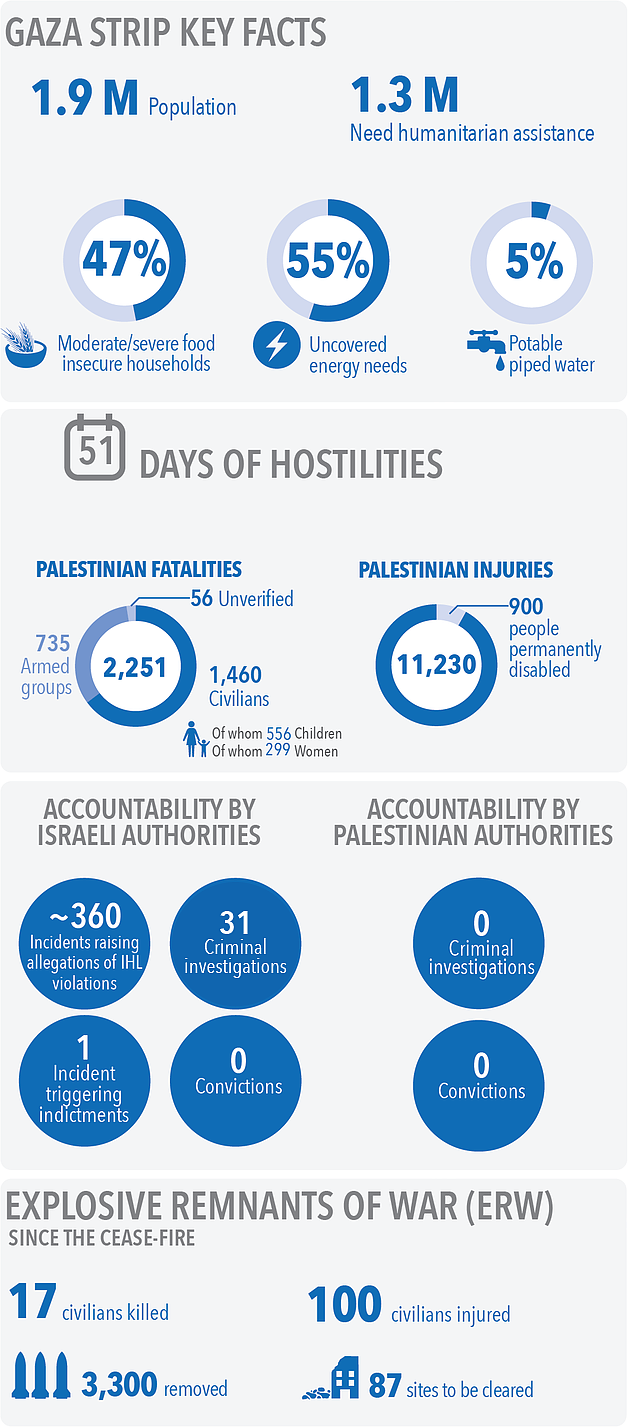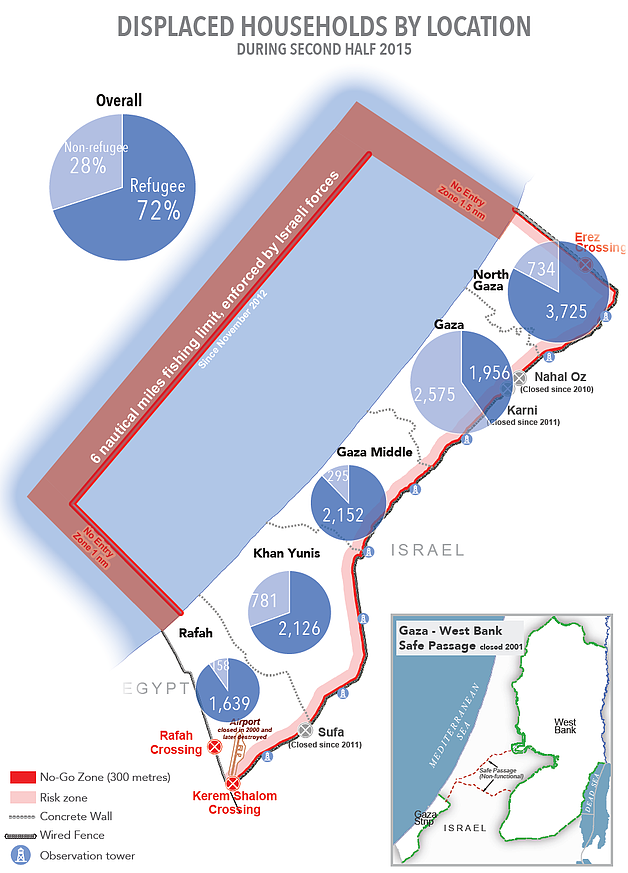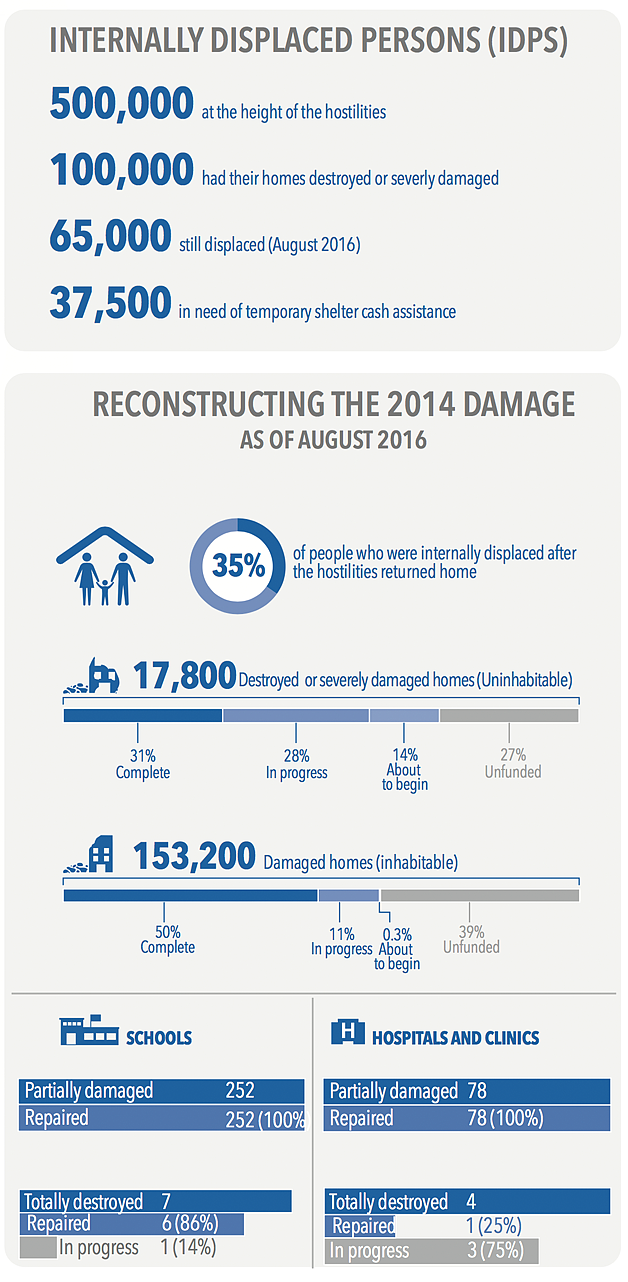Gaza: Two Years since the 2014 hostilities | August 2016
Key facts
- Of the approximately 100,000 Palestinians who had their homes destroyed or severely damaged during the 2014 hostilities, 65,000 remain displaced; over half of them may not receive any cash assistance during the second half of 2016, due to lack of funding.
- Some 900 people, a third of them children, sustained some form of permanent disability during the hostilities and about 100 underwent amputation of limbs.
- Over 160,000 children are estimated to be in need of continuous psychosocial support.
- Since the ceasefire, 17 civilians have been killed, and 100 have been injured by explosive remnants of war (ERW), including 46 children. Some 3,300 items of ERW have been safely removed and 87 hazardous sites are yet to be cleared.
- All 78 hospitals and clinics damaged during the conflict were repaired, reconstruction of three totally destroyed clinics is ongoing, and rebuilding of one hospital destroyed is yet to start.
- Of the seven totally destroyed schools, reconstruction of one is complete and work on the other six is ongoing; all the 252 damaged schools have been repaired.
- Repair of about two-thirds of the damage to the water and sanitation infrastructure and equipment is complete or underway, with the remaining third lacking funding; most households receive piped water only for a few hours every 2-4 days.
- Only half of the open-field crop areas, 18% of tree orchards, and 16% of greenhouses damaged or destroyed during the hostilities, have been restored, undermining farmers’ livelihoods and food production.
- Only 27% of the funding requested in the Humanitarian Response Plan 2016 for Gaza-specific projects has so far been received.
- Between 7 July and 26 August 2014, the Gaza Strip experienced the most devastating round of hostilities since the beginning of the Israeli occupation in 1967. Two years on, most people and institutions are still struggling to cope. The hostilities worsened an already dire humanitarian situation driven by the ongoing Israeli blockade and aggravated by the unresolved internal Palestinian divide . The work of humanitarian and development agencies to meet the basic needs of the most vulnerable is being impaired by severe underfunding.
- The living conditions of those still displaced raise a range of humanitarian concerns, including disrupted livelihoods, lack of privacy, genderbased violence, ERW-related risks, and exposure to weather extremes. This has exacerbated the vulnerability of certain groups, particularly children, women-headed households, peoples with disabilities, the elderly, and the chronically ill. The delays in the reconstruction of homes stems primarily from restrictions on the import of building materials, funding shortages, and constraints related to lack of planning and land ownership issues.
- The precarious situation of the public health system impedes the provision of appropriate care and rehabilitation to people who sustained long term injuries and disability. Gaza’s public health system suffers from major shortages in skilled personnel, drugs and disposables, and electricity supply. Many amputees are still waiting for prosthetic limbs, while other patients need to be referred outside of Gaza for regular treatment. The long waiting lists for elective surgery generate frustration, unnecessary pain and health risks associated with delayed care.
- Accountability for violations of international law during the hostilities remains elusive. The Israeli authorities have opened 31 criminal investigations, which, so far, have resulted in the indictment of three soldiers for a case of looting. Palestinian organizations taking cases to international judicial fora have faced threats and constraints. No meaningful investigation into alleged violations has been announced by Palestinian authorities. Impunity denies victims and survivors the justice and redress they deserve, and prevents the deterrence of future violations.
- Addressing the humanitarian needs from the 2014 conflict requires urgent measures and policy changes. These include a full lifting of Israel’s blockade, illegal under international law; a resolution of the internal Palestinian divide; and the disbursement of pending donor pledges. Those responsible for violations must be held accountable. Such changes are essential, not only to alleviate the current hardship, but also to reduce the likelihood of a new escalation.












